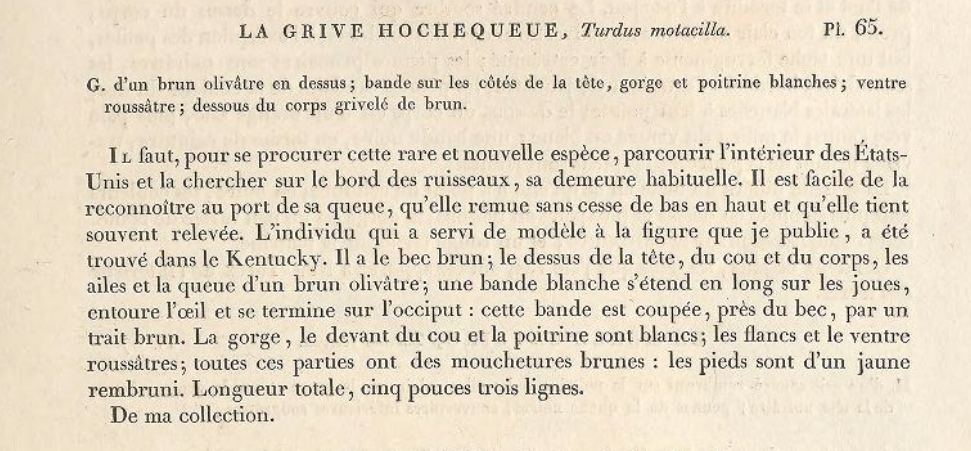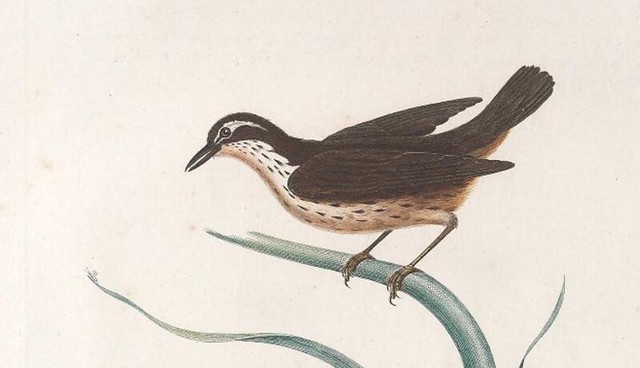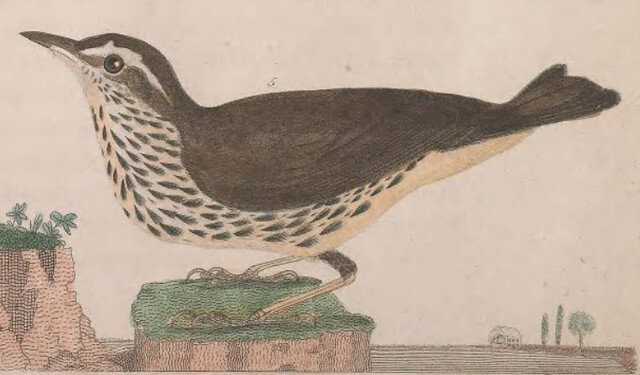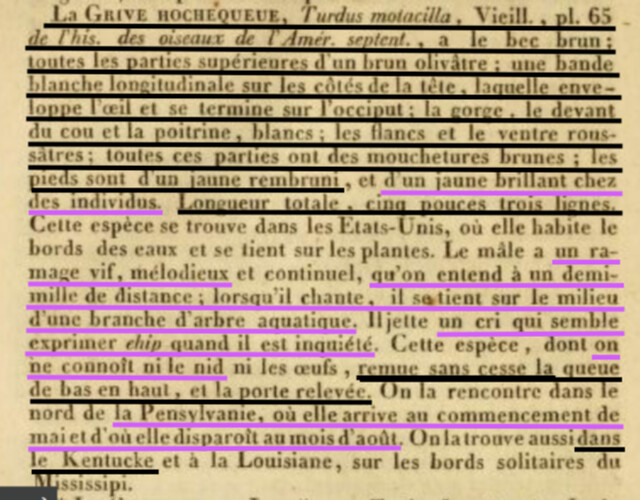The influence of Alexander Wilson’s writings on Louis Pierre Vieillot as he composed his Histoire naturelle des oiseaux de l’Amérique septentrionale is evident from the several passages in which the Frenchman cites, quotes, or — to indulge in an anachronism — plagiarizes the father of American ornithology.
What is less clear is exactly when Vieillot had access to Wilson’s work, a matter complicated by the uncertain dating of the fascicles making up his HIstoire naturelle. Volume One is dated 1807 on the title page, but Dickinson et al., in their useful Priority, argue cogently that the first installments did not arrive until 1808, and probably late 1808 at that.
Just how Vieillot used Wilson when he did have the American Ornithology at hand is a more interesting question. The easiest way to begin to answer it is to look at those species for which the French ornithologist published two accounts: one in the Histoire naturelle, apparently without benefit of Wilson, and another, the better part of a decade later, in the Nouveau dictionnaire, with the American Ornithology at his elbow.
One such example is found in Vieillot’s treatments of the Louisiana waterthrush, the first scientific description and naming of which he published in the Histoire naturelle in 1807 (or more likely 1808).

This is — Spencer Baird’s later doubts notwithstanding — the original description of the species we now know as Parkesia motacilla, and the accompanying plate by Prêtre is, faute de mieux, the type “specimen” of the Louisiana waterthrush.
Vieillot’s account is entirely his, uninfluenced by Wilson‘s (which is, after all, dated 1811), and apparently written without reference to Buffon’s equivocal description, published thirty years earlier.
A thrush with olive-brown upperparts; stripe on the side of the head, throat, and breast white; belly buffy; underparts spotted brown.
To obtain this rare new species, it is necessary to visit the interior United States and search for it in its customary abode alongside brooks. It is easy to identify from the way it holds its tail, which it ceaselessly wags upwards and often holds cocked. The individual depicted in the plate I publish here was collected in Kentucky. Its bill is brown; the top of the head, the neck, and the body, and the wings and tail are olive-brown; a white stripe extends above the cheek and around the eye, ending on the nape: this stripe is interrupted near the bill by a brown mark. The throat, the front of the neck, and the breast are white; flanks and belly buffy; all of these have brown spots: the feet are a brownish yellow. Total length five inches three lines.
From my collection.
Among the notable things here: Vieillot knew that his bird was new to science (he was already familiar with the northern waterthrush), and, as if the English names of warblers weren’t bad enough, the type locality is not Louisiana but Kentucky. He still thought it a true thrush of the genus Turdus, an understandable misapprehension; James Frances Stephens would gently point to the taxonomic future ten years later when he called the bird “the warbler thrush.”
In 1818, Vieillot published a second account of the Louisiana waterthrush, this time, though, having read Wilson’s work and his description of a bird Wilson had believed new, the “water thrush,” Turdus aquaticus. Vieillot determined that Wilson’s aquaticus was identical to his own motacilla — others have taken a different view over the past two centuries — and incorporated much of Wilson’s text into his updated and expanded account. The excerpt below, from volume 20 of the Dictionnaire nouveau, underlines in black the text taken over from Vieillot’s Histoire naturelle, in purple the material obviously borrowed from Wilson.
The concluding statement of range, “in Louisiana, on the deserted shores of the Mississippi River,” matches nothing in Wilson or in Vieillot’s earlier account, and is certainly drawn from Gmelin’s description of the northern waterthrush, published thirty years earlier and a source that Vieillot cites explicitly elsewhere.
Overall, this is a straightforward combination of texts, informative and nearly seamless. A couple of spots, however, remind us just why Vieillot might not have been more successful as an ornithologist in America. The awkward and rather odd notion that the singing male “perches halfway out on the limb of an aquatic tree” (“il se tient…”) is a misunderstanding of Wilson’s words “the musician is perched on the middle branches of a tree over the brook or river.”
That is a minor misreading, but Vieillot commits a more grievous error in mistranslating Wilson’s assessment of the species’ status in Pennsylvania:
about the beginning of May it passes through Pennsylvania to the north; is seen along the channels of our solitary streams for ten or twelve days; afterwards disappearing until August.
Even leaving aside the question of just which waterthrush species Wilson is talking about here, for Vieillot to assert that the Louisiana “arrives in northern Pennsylvania at the beginning of May and disappears in the month of August” is clearly based less on any new knowledge than on some notably poor English skills.
I am convinced that the efforts of some ornithophilologist someday to go through all of Vieillot’s writings will pay off. Exactly how we can’t yet say — but that’s the fun of it, after all.




